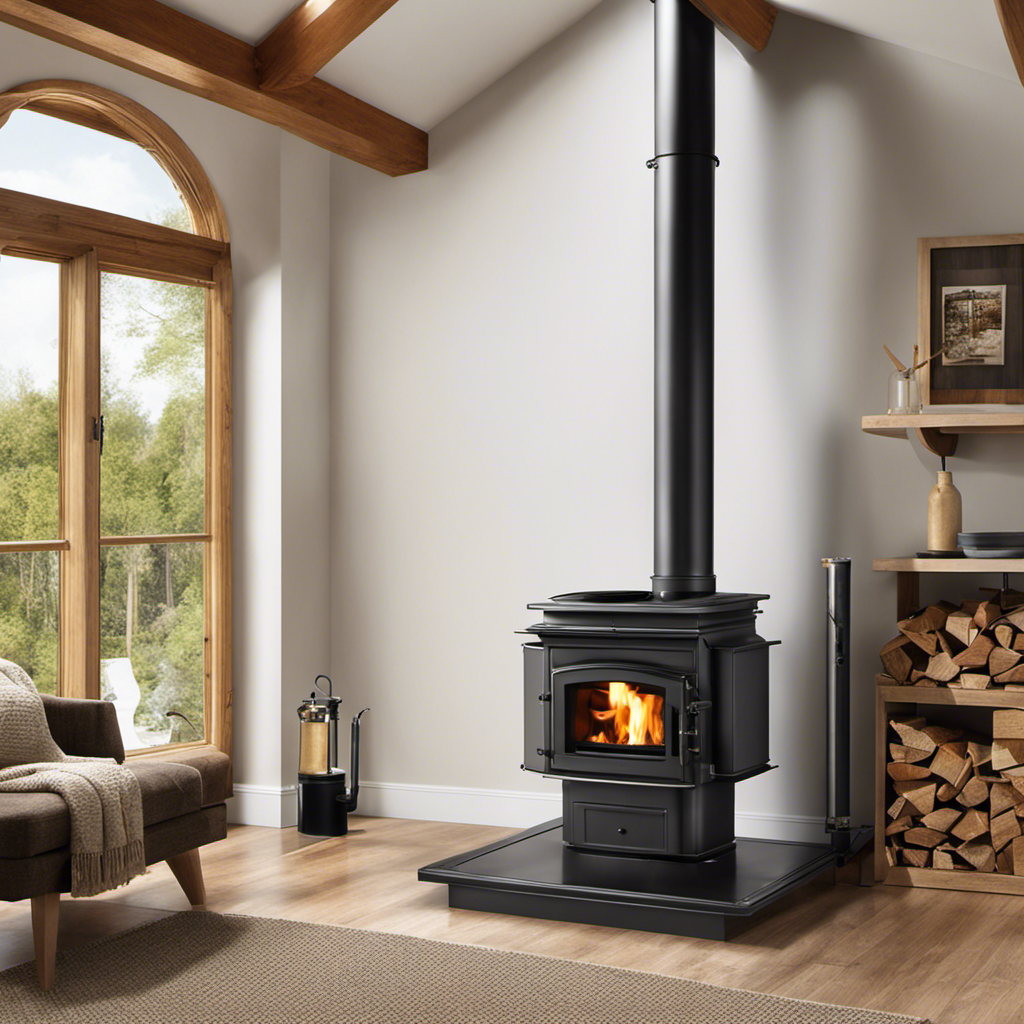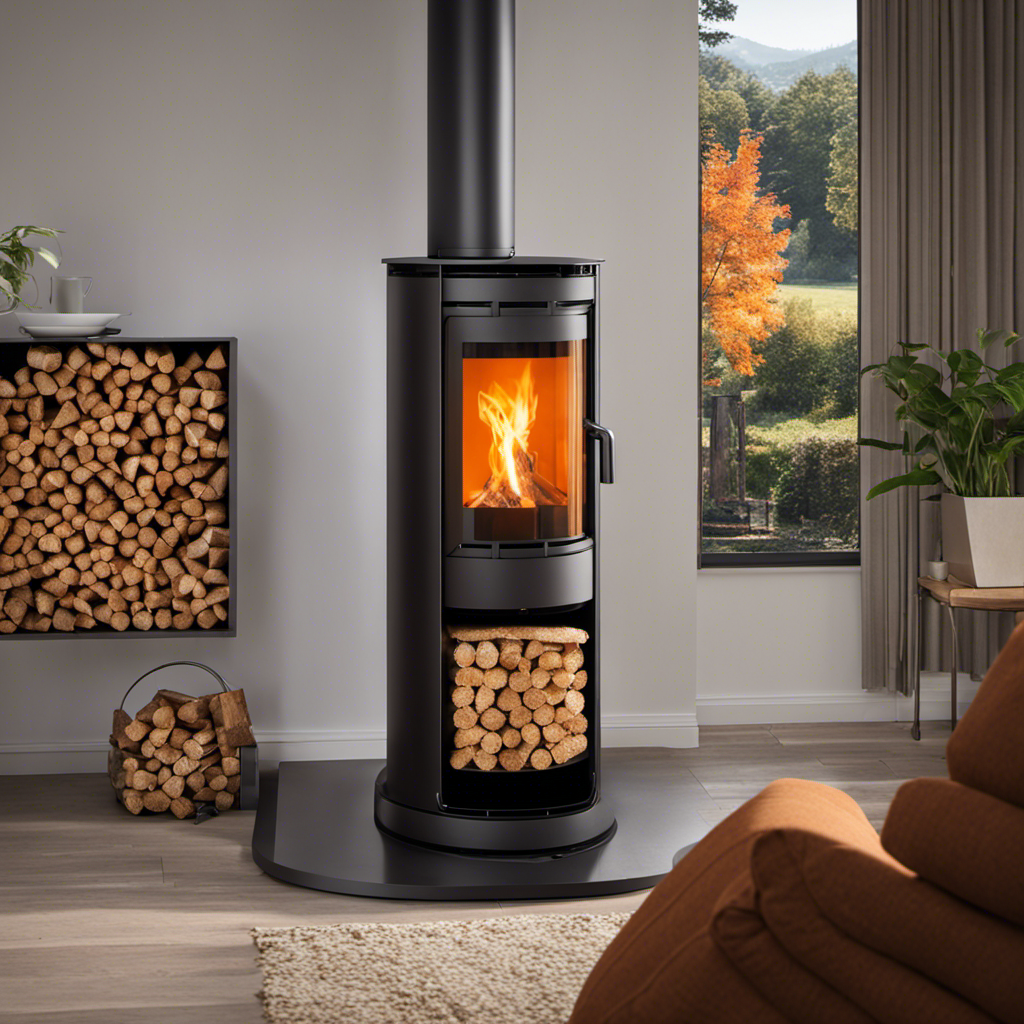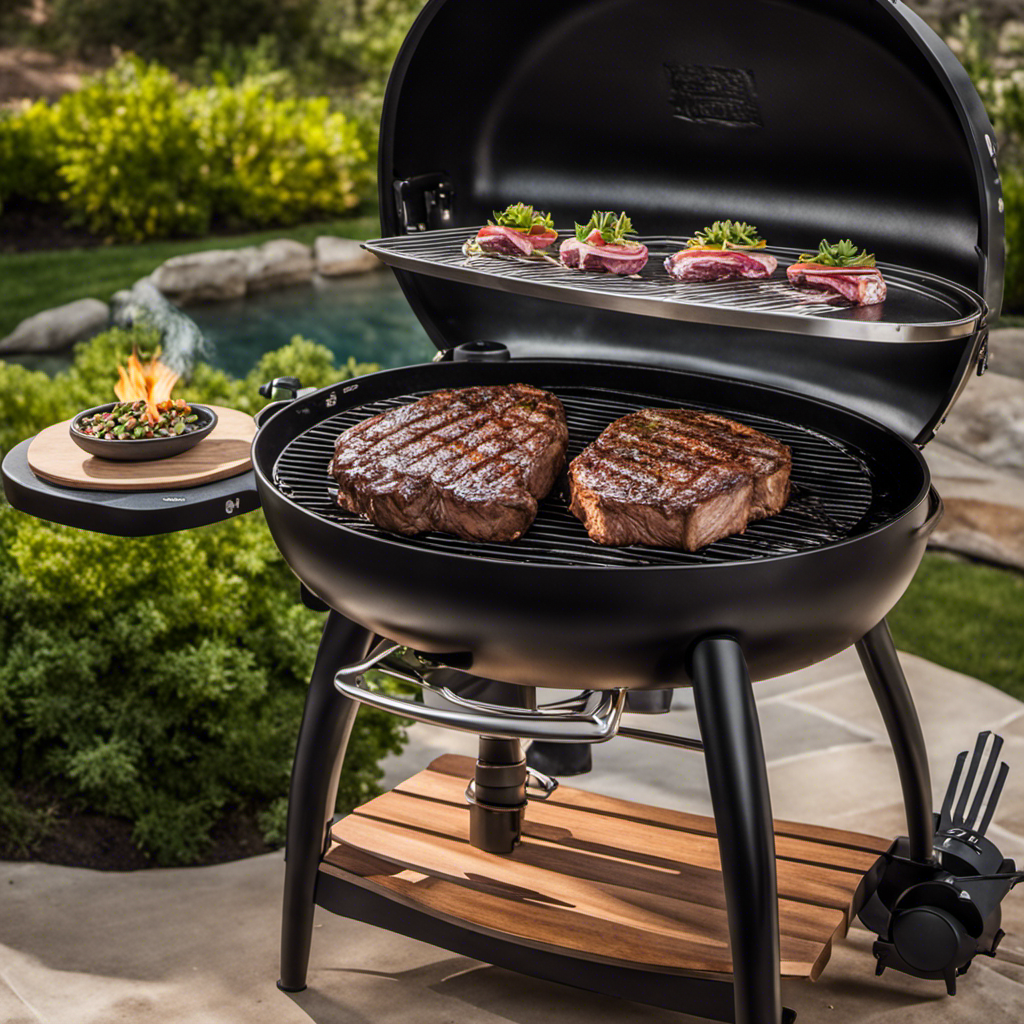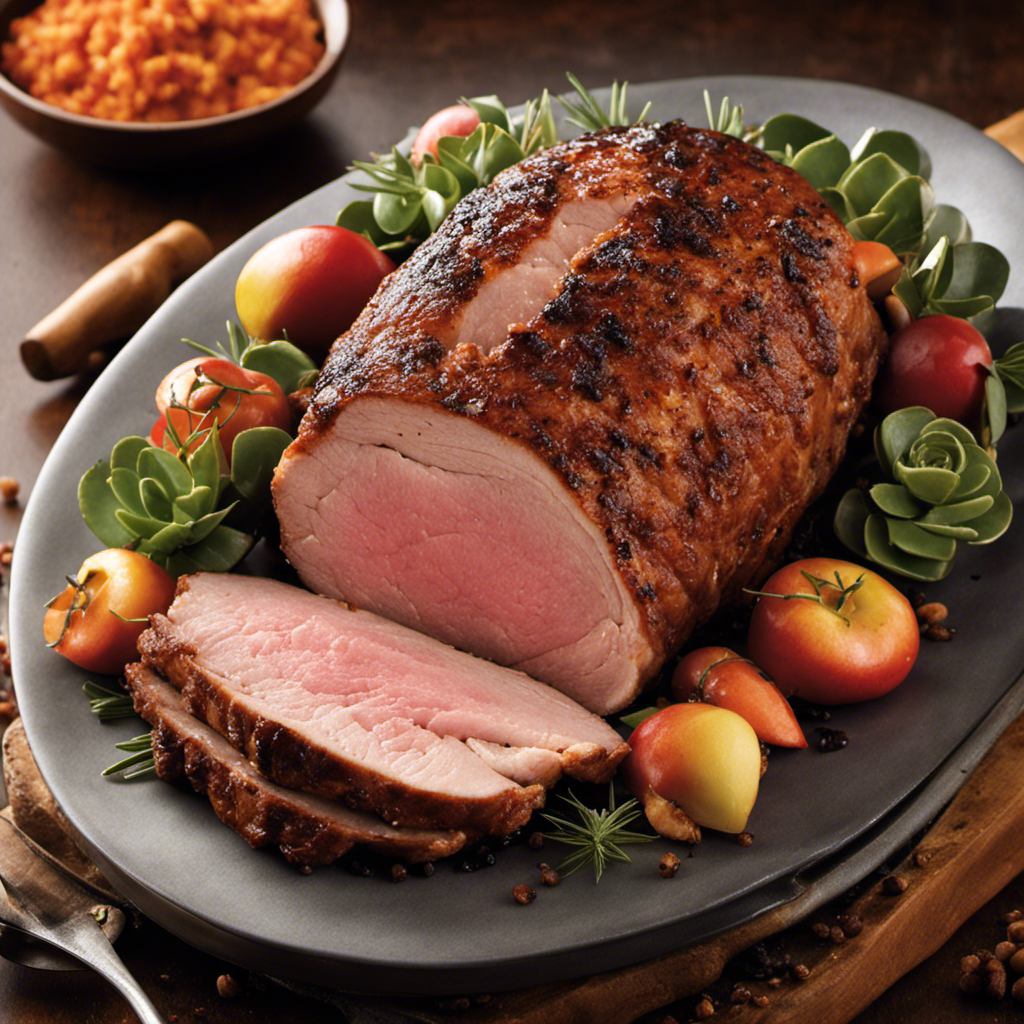I possess insider knowledge regarding the proper ventilation techniques for wood pellet stoves, and trust me, it changes the game. If you’ve ever experienced challenges in keeping your home warm and cozy during the chilly winter months, then you recognize the importance of ensuring your stove is ventilated accurately.
In this article, I’ll walk you through the ins and outs of wood pellet stove ventilation, from understanding the different types of venting systems to selecting the right materials and troubleshooting common issues.
So buckle up, because we’re about to take your heating game to the next level.
Key Takeaways
- Proper ventilation is essential for safe and efficient operation of wood pellet stoves.
- Vertical, horizontal, and direct venting systems are the main types used for wood pellet stoves.
- Vertical venting reduces indoor air pollution and can be hidden, but may require complex modifications.
- Horizontal venting is easier to install and convenient for limited spaces, but may not be as efficient and requires proper clearance.
Understanding Wood Pellet Stove Ventilation
Understanding how wood pellet stoves require proper ventilation is crucial for safe and efficient operation. Wood pellet stove ventilation regulations play a significant role in ensuring the safe use of these heating appliances.
Proper ventilation is important because it helps remove harmful combustion byproducts, such as carbon monoxide, from your home. Without proper ventilation, these byproducts can accumulate and pose a serious health risk.
Additionally, proper ventilation promotes efficient combustion by allowing a steady flow of fresh air into the stove, helping it burn the pellets more effectively. It also helps prevent the buildup of creosote, a highly flammable substance that can lead to chimney fires.
Now that we understand the importance of proper ventilation, let’s explore the different types of venting systems for wood pellet stoves.
Types of Venting Systems for Wood Pellet Stoves
When it comes to venting a wood pellet stove, there are two main options to consider: vertical venting and horizontal venting.
Vertical venting involves running the vent pipe straight up and out through the roof. This option has its own set of advantages and considerations.
Horizontal venting, on the other hand, involves running the pipe horizontally through an exterior wall. Again, this option has its own pros and cons.
One popular choice is direct venting, which offers several benefits such as improved efficiency, increased safety, and easier installation.
Ultimately, the right venting system for your wood pellet stove will depend on factors like the layout of your home, local building codes, and personal preferences.
Vertical Vs Horizontal Venting
To properly vent your wood pellet stove, you should consider whether vertical or horizontal venting is more suitable for your specific situation. Here are the key points to consider when deciding between the two options:
-
Vertical Venting:
- Advantages: Vertical venting allows you to direct the exhaust gases upwards and out of your home, reducing the risk of indoor air pollution. It can also be more aesthetically pleasing as the vent pipe can be hidden behind walls or in chimneys.
- Disadvantages: Installing vertical venting may require more complex and expensive modifications to your home’s structure. It also requires a clear path for the vent pipe to reach the roof, which may not be feasible in all situations.
-
Horizontal Venting:
- Advantages: Horizontal venting is often easier and more cost-effective to install, as it doesn’t require modifications to your home’s structure. It can be a convenient option if you have limited space or obstacles preventing vertical venting.
- Disadvantages: Horizontal venting may not be as efficient as vertical venting, as it allows for the accumulation of condensation and debris in the pipe. It also requires proper clearance from combustible materials to ensure safety.
Considering these factors, you can make an informed decision on whether vertical or horizontal venting is the best choice for your wood pellet stove.
Transitioning to the subsequent section about the benefits of direct venting, it’s important to understand the advantages it offers over both vertical and horizontal venting methods.
Benefits of Direct Venting
If you’re looking for a safer and more efficient option, direct venting offers several benefits over vertical and horizontal venting methods.
One of the main advantages of direct venting is that it eliminates the need for a chimney. This means that you can install a wood pellet stove in any room of your house, without the need for extensive ductwork or modifications to your existing structure.
Another reason for choosing direct venting is that it provides superior air quality. With direct venting, the combustion air is drawn from outside the house, which prevents any fumes or pollutants from entering your living space.
Additionally, direct venting is highly efficient, as it allows for a more controlled and consistent airflow, resulting in better heat distribution and fuel consumption.
When it comes to choosing the right system, there are a few factors to consider.
Choosing the Right System
One important factor to consider when choosing the right system is your specific heating needs. There are several options available for venting wood pellet stoves, each with its advantages and considerations. To help you make an informed decision, let’s compare the advantages of different systems in the table below:
| Venting Option | Advantages |
|---|---|
| Direct Venting | Provides greater efficiency and safety |
| Power Venting | Allows for flexible installation options |
| Natural Draft | Requires minimal maintenance and cost |
| Pellet Stove Insert | Can be easily installed in an existing fireplace |
| Horizontal Venting | Offers versatility in installation |
As you can see, each venting option has its benefits depending on your specific requirements. Now, let’s explore the venting options for different house structures, ensuring you choose the right venting system for your home.
Venting Options for Different House Structures
When it comes to venting options for wood pellet stoves in different house structures, there are several key points to consider.
Firstly, you have the choice between using a chimney or direct venting system.
Secondly, you need to determine whether a horizontal or vertical venting configuration is more suitable for your specific setup.
Lastly, if you have a multi-story home, there are additional considerations to keep in mind to ensure proper venting and safety.
Chimney Vs. Direct Venting
You should consider the advantages of direct venting for your wood pellet stove instead of relying solely on a chimney. Direct venting offers several benefits over traditional chimney installation. First, it provides a more efficient and controlled airflow, resulting in better combustion and heat distribution. Second, direct venting eliminates the need for a chimney, saving you the hassle and cost of chimney installation. Lastly, direct venting allows for greater flexibility in stove placement, as it can be vented horizontally or vertically.
To help you visualize the advantages of direct venting, here is a comparison table:
| Advantages of Direct Venting | Disadvantages of Chimney Installation |
|---|---|
| Efficient airflow | Costly chimney installation |
| Better combustion | Limited stove placement options |
| Flexibility in venting | Maintenance and cleaning requirements |
Now that you understand the benefits of direct venting, let’s delve into the decision of whether to go horizontal or vertical.
Horizontal or Vertical?
To choose between horizontal or vertical venting, consider the space available in your home and the specific requirements of your stove’s installation.
When it comes to wood pellet stoves, both horizontal and vertical venting options have their advantages. However, there are some unique benefits to choosing horizontal venting.
One advantage of horizontal venting is that it allows for greater flexibility in terms of installation. If you have limited vertical space or obstacles like beams or walls, horizontal venting can be a more practical solution.
Additionally, horizontal venting can be less expensive and easier to install compared to vertical venting. It requires fewer materials and can be a more straightforward process.
However, it’s important to note that horizontal venting may not be suitable for multi-story homes or if you have a long horizontal run. It’s crucial to take these factors into consideration when deciding on the best venting option for your wood pellet stove.
Consideration for Multi-story
If your home has multiple levels, it’s important to consider the suitability of horizontal venting for your installation. When dealing with a multi-story house, there are a few key considerations to keep in mind.
One of the main installation challenges is ensuring that the horizontal venting system can properly exhaust the combustion gases from the wood pellet stove on all levels. This may require additional planning and modifications to the existing venting system. It’s crucial to consult with a professional to determine the best approach for your specific home layout.
By taking into account the multi-story considerations and addressing the installation challenges, you can ensure that your wood pellet stove operates safely and efficiently throughout your entire home.
Now, let’s move on to sizing and calculating ventilation requirements for your wood pellet stove.
Sizing and Calculating Ventilation Requirements
The first step in sizing and calculating ventilation requirements for wood pellet stoves is to determine the square footage of the space. This is crucial in order to accurately calculate the ventilation capacity needed for proper venting installation.
To ensure a successful ventilation system for your wood pellet stove, there are a few key factors to consider:
- Take into account the height of the ceilings, as this will affect the amount of air that needs to be circulated.
- Consider the insulation of the space, as well-insulated areas may require less ventilation.
- Evaluate the layout of the room and any potential obstructions that may impede the airflow.
By taking these factors into consideration when calculating ventilation capacity, you can ensure that your wood pellet stove operates efficiently and safely.
With the ventilation requirements determined, the next crucial step is to select the right venting materials for wood pellet stoves.
Selecting the Right Venting Materials for Wood Pellet Stoves
When selecting the right materials for your wood pellet stove’s ventilation system, consider factors such as durability, compatibility, and ease of installation. It’s crucial to choose venting materials that can withstand the high temperatures produced by the stove and are designed specifically for pellet stoves.
Stainless steel vent pipes are a popular choice due to their durability and resistance to corrosion. Additionally, make sure the venting materials you select are compatible with your particular stove model and meet the necessary safety standards.
Ease of installation is also important, so look for venting systems that offer simple and straightforward installation procedures. By carefully selecting the right venting materials, you can ensure proper ventilation for your wood pellet stove and maintain its efficiency and safety.
To install horizontal venting for wood pellet stoves, you’ll need to follow a few important steps.
Installing Horizontal Venting for Wood Pellet Stoves
To properly install horizontal venting for your wood pellet stove, start by choosing the right venting materials for your specific model. It is important to follow venting regulations to ensure safe and efficient operation of your stove. Here is a table outlining the materials commonly used for horizontal venting:
| Material | Description | Benefits |
|---|---|---|
| Stainless Steel | Durable and resistant to corrosion | Long-lasting and reliable |
| Aluminum | Lightweight and easy to install | Cost-effective |
| Galvanized Steel | Affordable and easily available | Suitable for most setups |
When installing horizontal venting, make sure to carefully follow the manufacturer’s guidelines and local building codes. It is crucial to maintain proper clearances from combustible materials and ensure a secure and airtight connection between venting components. As horizontal venting requires a slight downward slope for condensation drainage, be mindful of the positioning and angles of the pipes. Now, let’s move on to vertical venting: tips and guidelines for proper installation.
Vertical Venting: Tips and Guidelines
When it comes to venting options for wood pellet stoves, horizontal venting is a popular choice for many homeowners. It offers flexibility in terms of installation and can be a great option for those who don’t have access to a vertical chimney.
However, if you already have an existing chimney, venting through it can be a convenient and cost-effective solution. In this discussion, I will delve into the different horizontal venting options available and provide guidance on venting through an existing chimney.
Horizontal Venting Options
There are several horizontal venting options available for wood pellet stoves. When it comes to venting options for small spaces, horizontal venting can be a great solution.
One of the advantages of horizontal venting is that it allows for flexibility in installation. With horizontal venting, you have the option to run the vent pipe through an exterior wall, which can be a convenient choice for homes with limited space or no existing chimney.
This type of venting is also beneficial for those who want to avoid the cost and hassle of installing a vertical vent system. However, it is important to ensure proper clearance and follow manufacturer guidelines for safe installation.
Now, let’s explore another popular venting option for wood pellet stoves: venting through an existing chimney.
Venting Through Existing Chimney
If you have an existing chimney, you can easily utilize it for venting your wood pellet stove. This option is popular among homeowners because it allows them to utilize an already existing structure, saving time and money.
Here are three benefits of venting through an existing chimney:
-
Cost-effective: Using an existing chimney eliminates the need for additional venting materials, reducing installation costs.
-
Efficient heating: Chimneys provide a natural draft that helps expel combustion gases, ensuring efficient heating and better stove performance.
-
Aesthetically pleasing: Venting through a chimney maintains the traditional look of a fireplace, adding a cozy and charming touch to your home.
However, it’s important to note that chimney venting may have some disadvantages compared to direct venting. Chimneys can be less energy efficient and require regular maintenance to prevent blockages or leaks. To ensure optimal performance, it’s crucial to properly seal and insulate venting systems.
Properly Sealing and Insulating Venting Systems
To properly seal and insulate venting systems for wood pellet stoves, it’s important to use high-quality materials. Effective sealing techniques and insulation methods ensure that the venting system functions optimally, preventing any leaks or heat loss.
One commonly used material for sealing is high-temperature silicone caulk, which creates an airtight seal around joints and connections. Additionally, foil tape can be used to seal any gaps or openings in the vent pipe.
Insulation is also crucial to minimize heat loss and improve the stove’s efficiency. Insulated vent pipe, such as double-wall stainless steel or ceramic fiber insulation, can be used to reduce heat transfer. It’s important to follow the manufacturer’s guidelines and local building codes when selecting and installing sealants and insulation.
With a properly sealed and insulated venting system, you can ensure safe and efficient operation of your wood pellet stove.
Transitioning into the subsequent section about maintaining and cleaning wood pellet stove ventilation, it’s important to regularly inspect and clean the venting system to ensure its continued effectiveness.
Maintaining and Cleaning Wood Pellet Stove Ventilation
After ensuring the proper sealing and insulation of your wood pellet stove venting system, it is essential to maintain and clean it regularly. This will help ensure the efficiency and safety of your stove. Here are some cleaning techniques and a maintenance schedule to keep in mind:
- Clean the vent pipes and flue regularly to prevent the buildup of creosote and other debris.
- Inspect the venting system for any signs of damage or blockages, such as nests or leaves.
- Check the exhaust vent outside to make sure it is clear and not obstructed by debris.
- Schedule an annual professional inspection and cleaning to ensure optimal performance and safety.
By following these cleaning techniques and sticking to a maintenance schedule, you can prolong the lifespan of your wood pellet stove and prevent potential issues.
Now, let’s move on to troubleshooting common venting issues with wood pellet stoves.
Troubleshooting Common Venting Issues With Wood Pellet Stoves
When troubleshooting common venting issues with wood pellet stoves, it’s important to check for any signs of blockages or damage in the venting system. Proper venting maintenance is crucial for the efficient and safe operation of your wood pellet stove.
One common issue is a blocked vent, which can prevent the proper flow of exhaust gases. Check for any debris or bird nests that may be obstructing the vent.
Another issue to look out for is a damaged vent pipe, which can lead to leaks and poor ventilation. Inspect the vent pipe for any cracks, holes, or loose connections.
Additionally, improper installation or sizing of the venting system can cause issues. Ensure that the venting system is correctly installed according to the manufacturer’s instructions.
Are There Different Methods for Venting Wood Pellet Stoves, or Is it the Same Process?
Yes, there are different methods to vent wood pellet stoves. The most common methods are venting through a chimney or through a wall. It is essential to follow manufacturer guidelines to ensure proper installation and safety. Proper venting is crucial for efficient operation of a wood pellet stove.
Frequently Asked Questions
How Often Should I Clean the Venting System of My Wood Pellet Stove?
I clean the venting system of my wood pellet stove every 6 months to ensure proper airflow and prevent buildup of debris. Regular cleaning and inspection are essential for optimal performance and safety.
Can I Use the Same Venting System for Multiple Wood Pellet Stoves in My House?
Using the same venting system for multiple wood pellet stoves in your house has its pros and cons. It can save money and simplify installation, but it may lead to decreased efficiency and potential safety hazards.
Are There Any Safety Concerns Regarding Wood Pellet Stove Venting?
There are safety concerns when venting wood pellet stoves. It’s important to follow proper installation guidelines to avoid carbon monoxide leaks or fire hazards. Common mistakes include improper sealing or using incorrect venting materials.
What Are the Signs That Indicate a Problem With the Venting System of a Wood Pellet Stove?
When the venting system of a wood pellet stove is not functioning properly, it can be as alarming as a smoke alarm going off in the middle of the night. Common venting issues can be avoided with proper maintenance.
Can I Install a Wood Pellet Stove in a House Without an Existing Chimney or Venting System?
Yes, you can install a wood pellet stove in a house without an existing chimney or venting system. There are several venting options available, such as direct venting or through the wall venting.
Conclusion
In conclusion, venting wood pellet stoves is crucial for their efficient and safe operation. By understanding the different types of venting systems and selecting the right materials, you can ensure proper ventilation in your home.
Sizing and calculating ventilation requirements is important to maintain optimal performance. Proper sealing and insulation of the venting system is necessary to prevent any leaks or drafts.
Regular maintenance and cleaning will help avoid common venting issues. Remember, with the right knowledge and care, your wood pellet stove will keep you warm and cozy for years to come.
So, don’t go cold turkey on venting – it’s the key to a toasty home!
Logan’s affair with adventure began in childhood. He hailed from a small town where vast forests bordered one side and endless shores stretched on the other. His days were spent exploring uncharted woods, climbing tall trees, or listening to the tales of old sailors. This early immersion in a world brimming with stories and mysteries became the foundation of his passion for writing.











